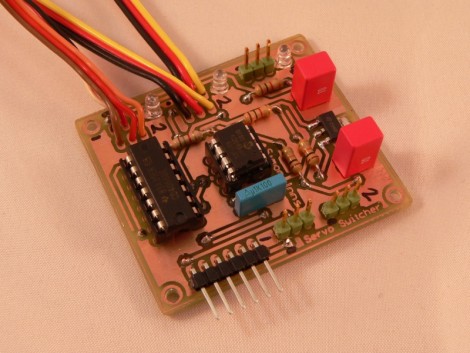
[Simon Inns] developed this board to act as a radio controlled override for autonomous hardware. It sits between some servo motors and two different sets of controllers for those motors. One set of hardware that can control the motors is a microcontroller programmed for autonomous tasks. In [Simon’s] case this enables a sailboat to navigate open water with out human intervention. But if that board fails, or if you just need to call the boat back to port, this module allows for a traditional RF vehicle controller to take command.
The board seen above, dubbed the Servo Switcher, uses a PIC 12F683 to monitor the incoming signal from the RF receiver. If that signal is not present it switches control of the motors over to a separate microcontroller board. This means that the override control is established simply by turning the handheld controller on. This will save you a swim to retrieve your boat, which is a nice convenience. But if you modify this for a plane or helicopter, it can save your aircraft from certain destruction. Check out the video walk through after the break.
[youtube=http://www.youtube.com/watch?v=8sm1w1PV5mw&w=470]















interesting concept, love it.
looks similar to something im working on. You can do allot of cool things with this setup. PS i think you meant off, not on.
Cool idea.
I’m not really sure how RF controller frequencies are handled but could a random harmonic or other unwanted signal enable the manual control if there is no authentication?
Great project. I’m knocking around a similar idea at the moment. My biggest problem is that I use the Spektrum R/C equipment, and when the transmitter is off the receiver continues to send valid servo signals. I still haven’t figured out a way to consistently detect when the transmitter is off versus on. In my case, I was using FPV (first-person video), and the on board transmitter caused a loss of control of my plane. I had the video transmitter behind a relay controlled by a R/C channel, but no control means that I couldn’t shut it down. Luckily, I was able to recover control before it crashed.
Anyway, I’d love to hear any ideas if people have solved this problem using Spektrum receivers.
@EMG – It doesn’t monitor the actual radio signal, instead it looks for a valid control signal between the radio receiver and the servo (which is a series of regular pulses at intervals of 10-30 mS). It also looks for 40 valid timed pulses in every 50 before considering the receiver active and switching over – so it should be hard to fool it.
Old concept/idea. There’s tons of commercial products that do this for professional robots, and DIY solutions that do the same. Ardupilot has a similar solution built in.
But this is a nice clean implmentation of the idea. Good job.
What’s the difference from this build, compared to Pololu’s 4 channels Multiplexer or similar product?
Except Pololu’s uses an channel for control.
@Scorp-D – the hardware design is CC licensed, the code is open-source, it doesn’t require an extra channel for control, you can reprogram it according to your requirements (in-circuit) and you can add as many channels as you like.
@Simon Inns-yeah, but other than that…. :)